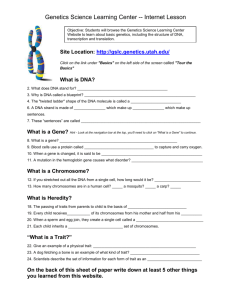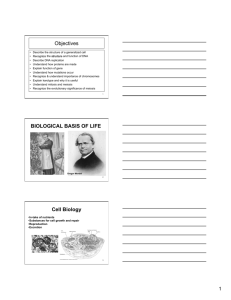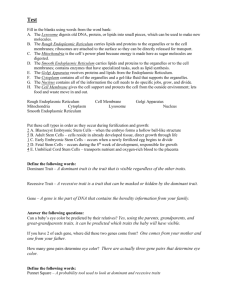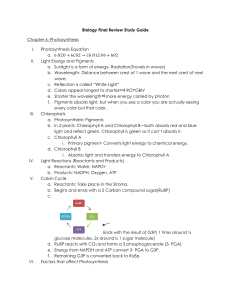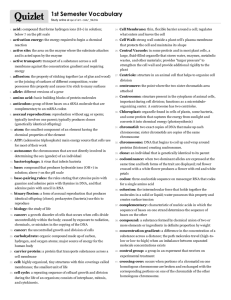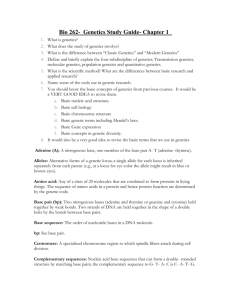Spring Biology Final Exam Study Guide
advertisement
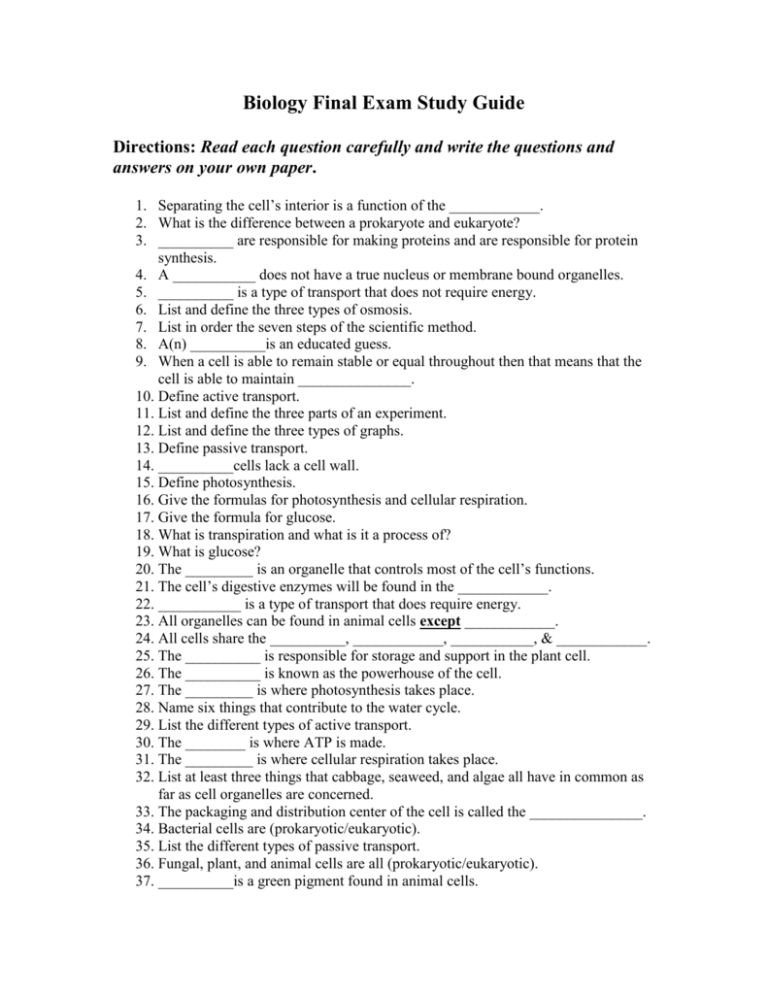
Biology Final Exam Study Guide Directions: Read each question carefully and write the questions and answers on your own paper. 1. Separating the cell’s interior is a function of the ____________. 2. What is the difference between a prokaryote and eukaryote? 3. __________ are responsible for making proteins and are responsible for protein synthesis. 4. A ___________ does not have a true nucleus or membrane bound organelles. 5. __________ is a type of transport that does not require energy. 6. List and define the three types of osmosis. 7. List in order the seven steps of the scientific method. 8. A(n) __________is an educated guess. 9. When a cell is able to remain stable or equal throughout then that means that the cell is able to maintain _______________. 10. Define active transport. 11. List and define the three parts of an experiment. 12. List and define the three types of graphs. 13. Define passive transport. 14. __________cells lack a cell wall. 15. Define photosynthesis. 16. Give the formulas for photosynthesis and cellular respiration. 17. Give the formula for glucose. 18. What is transpiration and what is it a process of? 19. What is glucose? 20. The _________ is an organelle that controls most of the cell’s functions. 21. The cell’s digestive enzymes will be found in the ____________. 22. ___________ is a type of transport that does require energy. 23. All organelles can be found in animal cells except ____________. 24. All cells share the __________, ____________, ___________, & ____________. 25. The __________ is responsible for storage and support in the plant cell. 26. The __________ is known as the powerhouse of the cell. 27. The _________ is where photosynthesis takes place. 28. Name six things that contribute to the water cycle. 29. List the different types of active transport. 30. The ________ is where ATP is made. 31. The _________ is where cellular respiration takes place. 32. List at least three things that cabbage, seaweed, and algae all have in common as far as cell organelles are concerned. 33. The packaging and distribution center of the cell is called the _______________. 34. Bacterial cells are (prokaryotic/eukaryotic). 35. List the different types of passive transport. 36. Fungal, plant, and animal cells are all (prokaryotic/eukaryotic). 37. __________is a green pigment found in animal cells. 38. What are food chains, food webs, and energy pyramids? 39. Plant cells do not share a ___________, __________, and a ___________ with the animal cell. 40. What is osmosis? 41. What are carrier proteins and what are they used for? 42. What is diffusion? 43. Name the three organisms that are found in most ecosystems and give a definition and the names that they are also called. 44. There are three types of consumers give their old names and then the names they are currently known by and a definition for each. 45. Animal cells will not have a _______________. 46. What does the cell theory state. 47. Bacterial cells belong to the kingdom ___________. 48. There were once five kingdoms and now there are six. List the previous five kingdoms and the new six kingdoms and give the characteristics of each. 49. List the three cycles and tell what happens during each one. 50. When and animal’s body does not have a certain shape then that means that their bodies are ___________. (Note: This deals with symmetry.) 51. Some animals have _________ symmetry which means that their bodies are arranged around a central point. 52. If an animal has distinctive right and left halves which means that one side mirrors the other then that means that these animals have _________________. 53. List and define the two types of animals. 54. List in order the 7 taxonomic groups. 55. How do you correctly write a scientific name? 56. What is the difference between taxonomy and binomial nomenclature? 57. Who is considered the father of genetics? 58. Sex cells or reproductive cells are called __________ in animals and they are called __________ in plants. 59. ___________ is a form of asexual reproduction in which identical offspring are produced. 60. ________ is a form of reproduction in which the number of chromosomes are reduced by half to form reproductive cells. 61. A _________ is a segment of DNA that codes for a protein or a RNA molecule. 62. A_________ consist of DNA tightly coiled around proteins. 63. Variation is increased during _________ because the offspring is not identical to the parent. 64. A ________ is a fertilized egg cell. 65. The _________ or 2n number or chromosomes represent the two sets of chromosomes which are found in the somatic cells. 66. ____________ has been referred to as the father of genetics. 67. ____________ are chromosomes that are not directly involved in determining the sex of an individual. 68. The _________ will determine the sex of the baby because they carry both types of chromosomes. 69. The multiple forms of a gene are called _________. 70. The trait or characteristic that will show up in an individual is said to be _________. 71. The _________ trait is characterized by what you see. 72. The _________ is those things that you can’t see but is either homozygous or heterozygous. 73. The passing of traits from parents to offspring is called ________. 74. _______ is the study of heredity. 75. The father of Genetic is known for his work with the _________. 76. Sections of DNA that determines specific traits are called __________. 77. Capital letters in Genetics represents the _________ genes or traits. 78. Lowercase letters represents the _________ genes or traits. 79. The letters “uu” represents a ________ gene pair. 80. The letters “Tt” represents a ________ gene pair. 81. The letter “WW” represents a _______ gene pair. 82. If a person is a carrier of gene or trait that does not show up then that gene or trait is __________. 83. The tool that is used to determine the outcome of genetic cross is called __________. 84. There are two types of vascular plants list, define, and give their alternate names. 85. If a plant is vascular then that means that it has _________ and ________. 86. List and define those two answers for # 85. 87. How does the guard cell and stomata relate? What are they? 88. What are nonvascular plants? Give two examples. 89. What are monocots and dicots? 90. The male part of the flower is the _________. 91. The female part of the flower is the _________. 92. What is the pistil and the stamen made up of? List and define the parts? 93. List and define the two types reproduction. 94. There are at least four types of asexual reproduction what are they? Define them. 95. Both ________ and ________ can speed up the reaction rate of a chemical reaction but only the ________ can be used up in the process or denatured by heat. 96. ________ is a structure that looks like a double helix. 97. What are the differences between the components of a DNA nucleotide and an RNA nucleotide? 98. What is the only difference between the nitrogenous bases in DNA and RNA? 99. What are the base pairing rules of DNA? RNA? 100. For the DNA sequence give the correct complimentary DNA bases? ATGCGTC 101. Now give the correct RNA bases. 102. Give the previous 5 kingdom and current six kingdom systems 103. List the organization of the cell.

